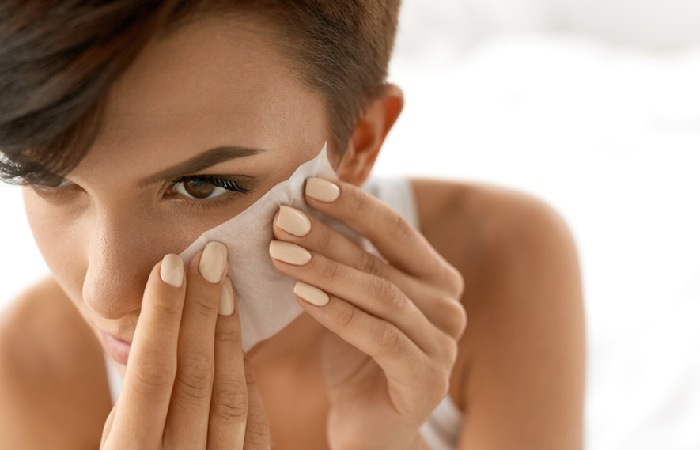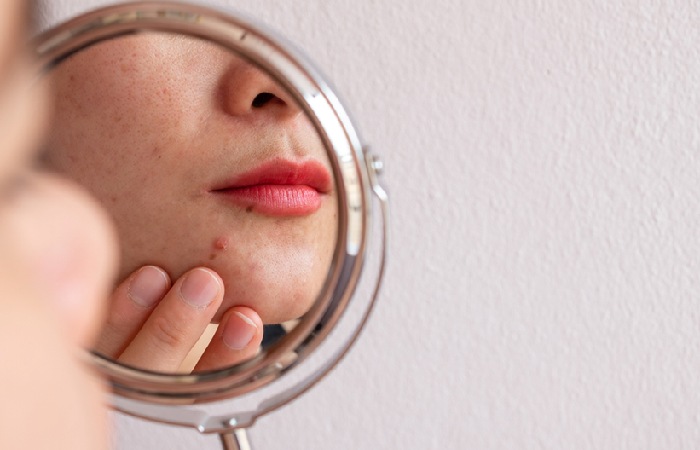Each person’s skin is unique, which means that each one of us has individual skincare needs as well. One person’s holy grail product may cause an allergic reaction in someone else, while other people need days or weeks to adjust their sensitive skin to a product. So how do you know if you’re just going through a purge phase or if a product genuinely isn’t working for your skin? Here are nine signs that your skincare products aren’t working for you:
Stinging and Burning
It’s normal for a chemical exfoliant product to cause some gentle tingling when you first apply it, but that feeling should fade in a few seconds or minutes. If you feel intense stinging or burning, or the sensation doesn’t fade, then you need to wash the product off immediately. This is a sign that the product is too strong for your face and that it’s damaging your skin barrier. If you leave it on too long, it can cause an allergic reaction or even a chemical burn. Skincare products shouldn’t sting or burn every time you use them!
Dryness and Tightness
You might experience mild dryness and tightness when you get adjusted to new skincare products containing certain ingredients, such as retinols. However, this dryness should be minor and temporary. If it persists, that’s a sign that your skin isn’t adjusting as it should and that you might need a lower concentration or a different ingredient. Your face might also feel dry and tight after using a foaming or gel cleanser, which indicates that it’s too drying for your skin and that you need to switch to a gentler formula as part of your 3-step skincare routine.
Flaky Patches and Peeling
If you let the dryness progress, you might get to the point where you have noticeable flakes of dead skin peeling off your face. While flaking patches and peeling can be a side effect of certain dermatology procedures (like in-office chemical peels) they’re not normal for at-home products. We know it’s tempting to pick these flakes off, but it will only make the dryness and peeling worse. Instead, give exfoliating products a break and focus on hydrating and moisturizing products to repair your skin barrier.

Oiliness and Greasiness
On the other hand, you might notice that your skin is producing noticeably more oil and looks greasy or shiny as a result. This excess oil production can lead to clogged pores and congestion sometimes as well. This can happen if you’re using products that are too drying for your face, which disrupts the balance of your skin barrier and triggers your cells to produce more sebum to compensate for the dryness. Try switching to higher-quality, less-stripping products to see if they help with the oiliness.
Breakouts and Skin Purging
You might also experience increased breakouts — but this can sometimes be a sign that the products are working. Skin purging is a phenomenon that occurs when you start using products that increase skin cell turnovers. By bringing old cells, dirt, and sebum to the surface, these products can cause breakouts for four to six weeks as your skin adjusts. If your skin continues to break out beyond that period of time, then the product just might not be well-suited to your skin and you might want to try something else.
Redness and Irritation
Redness and irritation are other signs that your skincare products are aggravating your skin, even if it doesn’t feel painful or itchy. Sometimes your skin might be red for a minute or two when you first apply a product because rubbing your face stimulates blood flow and makes you flush, but that should fade in a few minutes. If your face continues to look red or feel irritated, you should wash off the product and consider switching to a new one.

Rashes and Hives
Sometimes that redness and irritation can escalate into an all-out allergic reaction like rashes, hives, and contact dermatitis. Sometimes this reaction occurs right away, as soon as you apply a product for the first time, but other times the reaction can build over days or weeks. If you have very sensitive skin that seems to react to everything, we recommend keeping a skincare log that tracks the products you are using and how your skin is doing so you can trace your problems back to the source.
Difficulty Healing
If you are continuing to use skincare products that irritate your face, then you may notice that your skin takes longer to heal than it normally would. Small nicks and cuts may take a long time to close, and acne lesions can take a long time to clear up. You might also experience more scarring than normal or find that scars take a longer time to fade than they normally would. Try to avoid picking at cuts and blemishes, which will prolong the healing process. Instead, discontinue the use of potentially irritating products and focus on repairing your skin barrier so it can heal itself.
Discoloration and Hyperpigmentation
Some skincare products can temporarily change the color of your skin in either the short or long term. Sometimes this is only temporary: For instance, vitamin C can give skin an orange tint using the same mechanism as the DHA in self-tanner, but it fades quickly. In other cases the hyperpigmentation may be more stubborn and slow to fade, potentially lasting for weeks or months. If you suspect that a skincare product is contributing to hyperpigmentation, discontinue use immediately and consider talking to dermatologist about using a dark spot remover to safely fade the marks more quickly.
Have you ever used a skincare product that you wanted to love, but that simply didn’t work with your skin? Let us know about your experience in the comments


